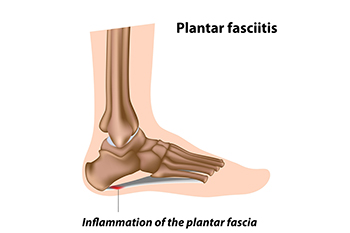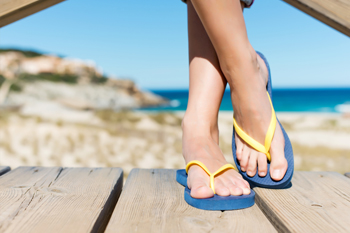Connect With Us
Blog
Items filtered by date: August 2022
Dealing With Ankle Ulcers

Ankle ulcers are sores that do not heal, usually because of weak blood circulation, and can last for a few weeks to a few years. Medically known as venous stasis ankle ulcers, they can occur when there is a break in the skin. If the valve in the vein that regulates blood flow is faulty, it results in a backflow. This in turn causes pressure that inhibits the ability of the skin, usually over bony areas like the ankle, to heal properly. Venous skin ulcers are more common among older people, particularly women. Chances for developing a venous skin ulcer increase if you have had a previous injury, smoke, have varicose veins, or are obese. These ankle ulcers are not always painful, but in some cases may burn or itch. If an ulcer becomes infected, it may leak green or yellow fluid. Treatment options vary, but include compression therapy, antibiotic medication, or in severe cases, surgery. If you notice a sore on your ankle that has not healed properly, it is suggested you consult a podiatrist as soon as possible for an exam and treatment recommendations.
Ankle pain can be caused by a number of problems and may be potentially serious. If you have ankle pain, consult with Imaze Marian Davis, DPM from Marian Davis, DPM, PA. Our doctors will assess your condition and provide you with quality foot and ankle treatment.
Ankle pain is any condition that causes pain in the ankle. Due to the fact that the ankle consists of tendons, muscles, bones, and ligaments, ankle pain can come from a number of different conditions.
Causes
The most common causes of ankle pain include:
- Types of arthritis (rheumatoid, osteoarthritis, and gout)
- Ankle sprains
- Broken ankles
- Achilles tendonitis
- Achilles tendon rupture
- Stress fractures
- Bursitis
- Tarsal tunnel syndrome
- Plantar fasciitis
Symptoms
Symptoms of ankle injury vary based upon the condition. Pain may include general pain and discomfort, swelling, aching, redness, bruising, burning or stabbing sensations, and/or loss of sensation.
Diagnosis
Due to the wide variety of potential causes of ankle pain, podiatrists will utilize a number of different methods to properly diagnose ankle pain. This can include asking for personal and family medical histories and of any recent injuries. Further diagnosis may include sensation tests, a physical examination, and potentially x-rays or other imaging tests.
Treatment
Just as the range of causes varies widely, so do treatments. Some more common treatments are rest, ice packs, keeping pressure off the foot, orthotics and braces, medication for inflammation and pain, and surgery.
If you have any questions, please feel free to contact our office located in Miami, FL . We offer the newest diagnostic and treatment technologies for all your foot care needs.
Types of Arthritis That Can Develop in the Feet

Research has indicated that approximately 50 percent of people who are in their 60’s and 70’s will develop arthritis in their feet. Additionally, if a patient has sustained a foot injury, arthritis may develop more quickly. The most common forms of arthritis in the feet include rheumatoid, gout, osteoarthritis, and posttraumatic. Osteoarthritis typically targets people who are 60 years or older and produces severe pain in the joints of the toes. It may be worse in the morning after arising and can often become inflamed. Gout is caused by having excess uric acid in the bloodstream that forms crystals that lodge in the joints of the big toe. The pain from gout can be debilitating. Rheumatoid arthritis may be triggered by an autoimmune disorder that can cause foot deformities if not treated promptly. If an injury has occurred, it may trigger posttraumatic arthritis, and this may cause pain and discomfort. It is important to control the inflammation and pain with any type of arthritis, and it is suggested that you seek the counsel of a podiatrist who can guide you toward correct treatment techniques.
Arthritis can be a difficult condition to live with. If you are seeking treatment, contact Imaze Marian Davis, DPM from Marian Davis, DPM, PA. Our doctors can provide the care you need to keep you pain-free and on your feet.
Arthritic Foot Care
Arthritis is a term that is commonly used to describe joint pain. The condition itself can occur to anyone of any age, race, or gender, and there are over 100 types of it. Nevertheless, arthritis is more commonly found in women compared to men, and it is also more prevalent in those who are overweight. The causes of arthritis vary depending on which type of arthritis you have. Osteoarthritis for example, is often caused by injury, while rheumatoid arthritis is caused by a misdirected immune system.
Symptoms
- Swelling
- Pain
- Stiffness
- Decreased Range of Motion
Arthritic symptoms range in severity, and they may come and go. Some symptoms stay the same for several years but could potentially get worse with time. Severe cases of arthritis can prevent its sufferers from performing daily activities and make walking difficult.
Risk Factors
- Occupation – Occupations requiring repetitive knee movements have been linked to osteoarthritis
- Obesity – Excess weight can contribute to osteoarthritis development
- Infection – Microbial agents can infect the joints and trigger arthritis
- Joint Injuries – Damage to joints may lead to osteoarthritis
- Age – Risk increases with age
- Gender –Most types are more common in women
- Genetics – Arthritis can be hereditary
If you suspect your arthritis is affecting your feet, it is crucial that you see a podiatrist immediately. Your doctor will be able to address your specific case and help you decide which treatment method is best for you.
If you have any questions, please feel free to contact our office located in Miami, FL . We offer the newest diagnostic and treatment technologies for all your foot care needs.
What Does an Ankle Sprain Feel Like?

Spraining your ankle is certainly not a pleasant experience. Not only can ankle sprains be painful, they can also take weeks to months to fully heal, depending on the severity of the sprain. Ankle sprains occur when the ligaments surrounding the ankle bones and joints become torn, stressed, or otherwise strained. If you suspect that you might have sprained your ankle, here are several symptoms that some patients might experience with an ankle sprain. First, an individual might be unable to put their weight on the affected ankle, and be incapable of walking or running. If you have an ankle sprain, you might also notice some degree of skin discoloration on the affected area or perhaps some bruising. You might even experience different sensations in the ankle, such as a feeling of swelling, tenderness, or stiffness. Ankle sprains happen to many different people, so if you think that you might be one of them, contact a podiatrist. Your podiatrist will be able to help you remedy the problem.
Ankle sprains are common but need immediate attention. If you need your feet checked, contact Imaze Marian Davis, DPM from Marian Davis, DPM, PA. Our doctors can provide the care you need to keep you pain-free and on your feet.
How Does an Ankle Sprain Occur?
Ankle sprains take place when the ligaments in your ankle are torn or stretched beyond their limits. There are multiple ways that the ankle can become injured, including twisting or rolling over onto your ankle, putting undue stress on it, or causing trauma to the ankle itself.
What Are the Symptoms?
- Mild to moderate bruising
- Limited mobility
- Swelling
- Discoloration of the skin (depending on severity)
Preventing a Sprain
- Wearing appropriate shoes for the occasion
- Stretching before exercises and sports
- Knowing your limits
Treatment of a Sprain
Treatment of a sprain depends on the severity. Many times, people are told to rest and remain off their feet completely, while others are given an air cast. If the sprain is very severe, surgery may be required.
If you have suffered an ankle sprain previously, you may want to consider additional support such as a brace and regular exercises to strengthen the ankle.
If you have any questions please feel free to contact our office located in Miami, FL . We offer the newest diagnostic and treatment technologies for all your foot and ankle needs.
Do I Have Plantar Fasciitis?

Of all the different potential sources of heel pain, plantar fasciitis is certainly one of the most common. In fact, a wide range of people are affected by this condition. Plantar fasciitis occurs when the plantar fascia becomes inflamed. The plantar fascia is a band of tissue that runs from the heel to the toes. Since plantar fasciitis can be very common, it is important to be aware of the many different typical symptoms. Commonly, those suffering from plantar fasciitis will experience some kind of pain in the heel or the arch of their foot, since the plantar fascia also supports the arch. If you notice that the pain in your heel is most pronounced in the morning when you take your first steps of the day or when you begin to walk after an extended period of rest, this could be an indicator of plantar fasciitis. If you suspect that you may have plantar fasciitis, it is suggested to contact a podiatrist as soon as possible. A podiatrist will then be able to perform a proper diagnosis by examining your feet and inquiring about your amount of regular physical activity.
Plantar fasciitis can be very painful and inconvenient. If you are experiencing heel pain or symptoms of plantar fasciitis, contact Imaze Marian Davis, DPM from Marian Davis, DPM, PA. Our doctors can provide the care you need to keep you pain-free and on your feet.
What Is Plantar Fasciitis?
Plantar fasciitis is the inflammation of the thick band of tissue that runs along the bottom of your foot, known as the plantar fascia, and causes mild to severe heel pain.
What Causes Plantar Fasciitis?
- Excessive running
- Non-supportive shoes
- Overpronation
- Repeated stretching and tearing of the plantar fascia
How Can It Be Treated?
- Conservative measures – anti-inflammatories, ice packs, stretching exercises, physical therapy, orthotic devices
- Shockwave therapy – sound waves are sent to the affected area to facilitate healing and are usually used for chronic cases of plantar fasciitis
- Surgery – usually only used as a last resort when all else fails. The plantar fascia can be surgically detached from the heel
While very treatable, plantar fasciitis is definitely not something that should be ignored. Especially in severe cases, speaking to your doctor right away is highly recommended to avoid complications and severe heel pain. Your podiatrist can work with you to provide the appropriate treatment options tailored to your condition.
If you have any questions please feel free to contact our office located in Miami, FL . We offer the newest diagnostic and treatment technologies for all your foot and ankle needs.
Do Your Child's Feet Hurt?
Flip-Flops and Bacteria

Despite their stylish appeal and popularity during the warm summer months, flip-flops can present several threats to the health of your feet. Since flip-flops lack a back strap, the wearer must scrunch their toes to keep the shoe on the feet. These toe contortions can cause pain and complications. Additionally, since flip-flops are but mere pieces of flat foam, they offer little to no support. You might, therefore, experience increased stress on the heel when walking with flip-flops because they offer no padding or cushioning. One often overlooked downside of wearing flip-flops is the extent to which they can accumulate bacteria. Especially if worn in cities, flip-flops can accumulate many different kinds of bacteria both on the top and bottom of the foam. If worn in cities during warm months and rainy seasons, environmental moisture will only help the bacteria thrive. Since flip-flops are open toed shoes that ultimately expose your entire foot, this accumulation of bacteria can be especially dangerous to your feet. Contact your podiatrist who will be able to help you select healthy summer footwear.
Flip-flops are not always the best choice of footwear. If you have any concerns about your feet or ankles, contact Imaze Marian Davis, DPM from Marian Davis, DPM, PA. Our doctors will assist you with all of your foot and ankle needs.
Flip-Flops and Feet
When the weather starts warming up, people enjoy wearing flip-flops. Flip-flops are comfortable, stylish, and easy to slip on and off; they're perfect for any summer beach goer. However, these shoes can cause harm to the feet.
How Can Flip-Flops Affect Me Long-Term?
- Ankle problems
- Hip problems
- Lower back problems
- Pain in the balls of the feet
- Problems with foot arches
- Changes in the way you walk
Are There Injuries Associated with Flip-Flops?
Yes. Since flip-flops are relatively weak and do not provide the same amount of support as sneakers, people who wear flip-flops regularly are more susceptible to injuries. On top of that, the open nature of the shoe makes your feet more prone to other problems, such as cuts and even infections. Common injuries and ailments include:
- Sprained ankles
- Blisters
- Infections
- Cuts and Scrapes
I like Wearing Flip-Flops. Are There Safe Alternatives?
When buying flip-flops, try to find ones that have sturdy soles and that are made of high-quality materials that will support for your feet. These flip-flops will cost more but will also last longer as a result.
If you have any questions please feel free to contact our office located in Miami, FL . We offer the newest diagnostic and treatment technologies for all your foot and ankle needs.


